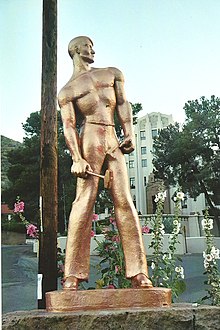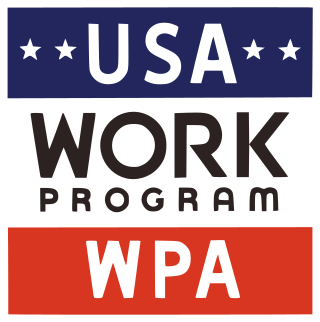
The Works Progress Administration was an American New Deal agency that employed millions of jobseekers to carry out public works projects, including the construction of public buildings and roads. It was set up on May 6, 1935, by presidential order, as a key part of the Second New Deal.

The Federal Art Project (1935–1943) was a New Deal program to fund the visual arts in the United States. Under national director Holger Cahill, it was one of five Federal Project Number One projects sponsored by the Works Progress Administration (WPA), and the largest of the New Deal art projects. It was created not as a cultural activity, but as a relief measure to employ artists and artisans to create murals, easel paintings, sculpture, graphic art, posters, photography, theatre scenic design, and arts and crafts. The WPA Federal Art Project established more than 100 community art centers throughout the country, researched and documented American design, commissioned a significant body of public art without restriction to content or subject matter, and sustained some 10,000 artists and craft workers during the Great Depression. According to American Heritage, “Something like 400,000 easel paintings, murals, prints, posters, and renderings were produced by WPA artists during the eight years of the project’s existence, virtually free of government pressure to control subject matter, interpretation, or style.”
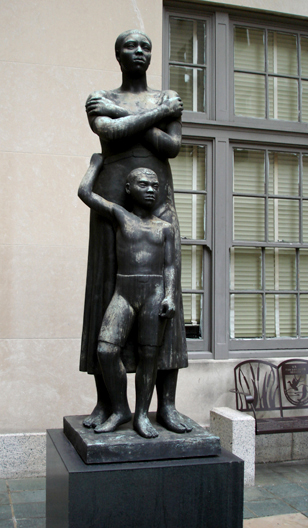
The Public Works of Art Project (PWAP) was a New Deal work-relief program that employed professional artists to create sculptures, paintings, crafts and design for public buildings and parks during the Great Depression in the United States. The program operated from December 8, 1933, to May 20, 1934, administered by Edward Bruce under the United States Treasury Department, with funding from the Federal Emergency Relief Administration.

Stevan Dohanos was an American artist and illustrator of the social realism school, best known for his Saturday Evening Post covers, and responsible for several of the Don't Talk set of World War II propaganda posters. He named Grant Wood and Edward Hopper as the greatest influences on his painting.
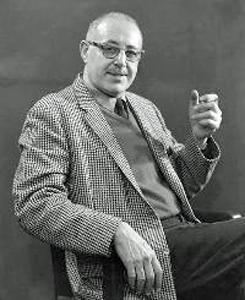
Harry Sternberg (1904–2001), was an American painter, printmaker and educator. He taught at the Art Students League of New York, from 1933 to c. 1966.

Seymour Fogel was an American artist whose artistic output included social realist art early in the century, abstract art and expressionist art at mid-century, and transcendental art late in the century. His drive to experiment led him to work with expected media – oil paints, watercolors, and acrylics – as well as unconventional media such as glass, plastics, sand, and wax.

The Treasury Section of Painting and Sculpture was a New Deal art project established on October 16, 1934, and administered by the Procurement Division of the United States Department of the Treasury.

The Wall Street crash of 1929 left many artists in the United States unemployed. Collectors who normally could afford to purchase such luxury items no longer had the means to do so. President Franklin D. Roosevelt's New Deal program created funding for art projects which would inspire confidence in American life and history. The program's objective was to hire artists to create works of art for display in public buildings throughout the country. From 1934 to 1943, there were various federally funded programs for artists in New Mexico – the Treasury Section of Painting and Sculpture, the Public Works of Art Project (PWAP), the Works Progress Administration (WPA)/Federal Art Project (WPA/FAP), and the Treasury Relief Art Project (TRAP).

United States post office murals are notable examples of New Deal art produced during the years 1934–1943.

Lucile Esma Lundquist Blanch was an American artist, art educator, and Guggenheim Fellow. She was noted for the murals she created for the U.S. Treasury Department's Section of Fine Arts during the Great Depression.
William Davenport Griffen was an American artist and muralist.

Elizabeth E. Terrell was an American artist who completed works for the Works Progress Administration. Born in Toledo, Ohio, Terrell is known for her abstract and modern figures, still life paintings, and murals. She exhibited her art at the Art Institute of Chicago, Brooklyn Museum of Art, Metropolitan Museum of Art, Museum of Modern Art, New York, Pennsylvania Academy of Fine Arts and Whitney Museum of American Art. She did frescos, mixed media, mosaics, gouache and oil paintings. She produced a mural at the Starke, Florida Post Office titled "Reforestation" (1942). She was part of an exhibition with Rufino Tamayo and Julian Levi at the Ottumwa Art Center in Ottumwa, Iowa. Her work is in the collection of the Smithsonian American Art Museum.

George Albert Harris, also known as George Harris (1913–1991), was an American painter, muralist, lithographer, and educator. He was a participant in the WPA Federal Art Project and was among the youngest artists on the mural project at Coit Tower. Harris' style is California Modernism, often working in abstraction, focusing primarily on still lifes and portraits.
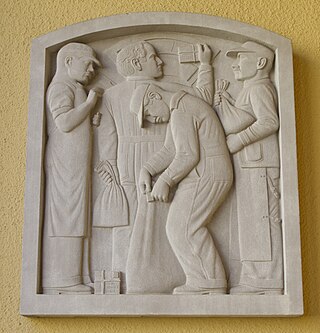
The Treasury Relief Art Project (TRAP) was a New Deal arts program that commissioned visual artists to provide artistic decoration for existing Federal buildings during the Great Depression in the United States. A project of the United States Department of the Treasury, TRAP was administered by the Section of Painting and Sculpture and funded by the Works Progress Administration, which provided assistants employed through the Federal Art Project. The Treasury Relief Art Project also created murals and sculpture for Public Works Administration housing projects. TRAP was established July 21, 1935, and continued through June 30, 1938.
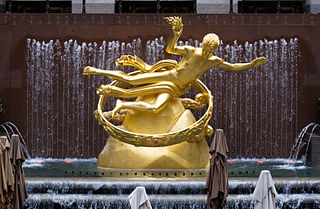
The Art Deco style, which originated in France just before World War I, had an important impact on architecture and design in the United States in the 1920s and 1930s. The most notable examples are the skyscrapers of New York City, including the Empire State Building, Chrysler Building, and Rockefeller Center. It combined modern aesthetics, fine craftsmanship, and expensive materials, and became the symbol of luxury and modernity. While rarely used in residences, it was frequently used for office buildings, government buildings, train stations, movie theaters, diners and department stores. It also was frequently used in furniture, and in the design of automobiles, ocean liners, and everyday objects such as toasters and radio sets.

Hyman J. Warsager (1909–1974) was an American artist known for his printmaking.
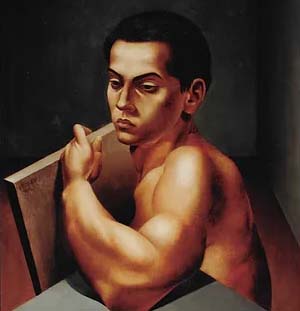
Harold Lehman (1913–2006) was an American artist known for his murals for the Works Progress Administration (WPA).
